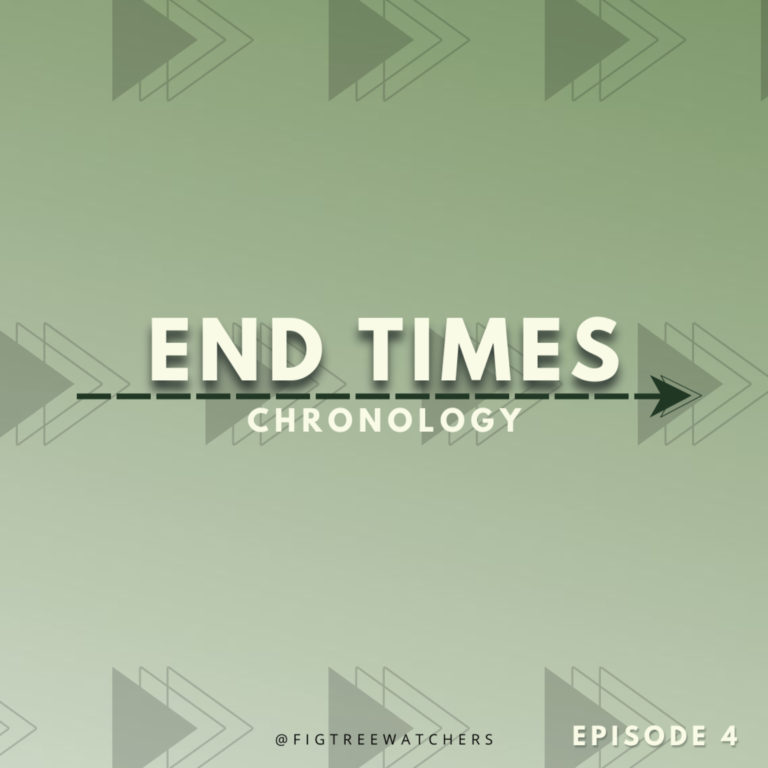
To share the Gospel, through the expository teaching of Scripture. Creating disciples-of Christ. Encouraging others to love God and others.
Website: www.figtreewatchers.com
Instagram: https://www.instagram.com/figtreewatchers/
Facebook: https://www.facebook.com/figtreewatchers/
Telegram: https://t.me/figtreewatchers
In this episode we wrapped up our look into the varying views on the millennial and discussed a few more issues we have with the amillennial and postmillennial viewpoints.
Co-Hosted by Ayomikun Shosanya & Stephan Caraway.
Navigate to the links below to access the show notes for this episode which contains links to the stories we went over as well as articles, social media accounts, and other resources. If you enjoyed this episode, and are blessed by the ministry, we’d greatly appreciate it if you left a rating and a review.
Episode 141
Episode notes:
https://www.figtreewatchers.com/figtreewatchers-podcast-episode-141-end-times-chronology-the-millennium-part-2/
Website: www.figtreewatchers.com
Instagram: https://www.instagram.com/figtreewatchers/
Facebook: https://www.facebook.com/figtreewatchers/
Telegram: https://t.me/figtreewatchers
Email: [email protected]

In this episode we wrapped up our look into the varying views on the millennial and discussed a few more issues we have with the amillennial and postmillennial viewpoints. For a downloadable version of the show notes, click download below.
Problems with the Views
Amillennialism – Lumping Judgments into One
The Biggest issue for Amillennialist, is that they lump all the Judgments into one big one, while the premillennial view sees four judgments (The Bema, The Judgment of nations, The Judgment of Israel, The Great White Throne Judgment).
They believe that Revelation 12 is a summary recapping of Christ’s triumphant victory over Satan and all evil, when he died on the cross. They argue that Satan and his forces have been bound and the Saints reign victoriously. (Rev 20) Then why is there Evil?
Amillennialism/Postmillennialism – The Kingdom in our Hearts
Norman Shepherd defines postmillennialism as “the view that Christ will return at the end of an extended period of righteousness and prosperity (the millennium).” Like the amillennialist, the post-millennialist sees the current age as the kingdom of God. However, they see the reign of Christ not just in the hearts of believers today, but as impacting society.”
Postmillennialism – The Kingdom is not our doing
“Postmils believe that since the kingdom was established at Christ’s first coming, it is currently being expanded through the preaching of the gospel, until an overwhelming major, though not all, will be converted to Christ. Such Gospel success will create a climate of reception to the things of Christ, like His mediated rule through the church of all the world. Shepherd further explains:
[The postmillennialist] expects a future period when revealed truth will be diffused throughout the world and accepted by the vast majority. The millennial era will therefore be a time of peace, material prosperity, and spiritual glory.”
“The millennium will be of extended duration though not necessarily a precise 1,000 years. Because it is established through means presently operative, its beginning is imperceptible. Some postmillennialists provide for a gradual establishment of the millennium.”1
Amillennialism/Postmillennialism – Timeline of the Coming of the Kingdom
Passages such as Daniel 2, 7; Matthew 13 and 25; Revelation 17, 19 consistently shows us a specific order of events regarding the instituting of the kingdom.
We first get the return of the king, he judges the wicked, and then the kingdom is manifested on earth; king first, then the kingdom. This is an important fact to highlight as both amillennialism and postmillennialism presents an opposing viewpoint – that we are currently in the kingdom and it’s only after this current age runs its course that the king comes to judge the wicked and finally usher in the eternal state.
A tweet thread Ayo was in relating to this discussion:
Amillennialism/Postmillennialism – Unfulfilled OT Prophecies
- The nations will go to Jerusalem every year for the feast of tabernacles. If they don’t, they’ll get no rain (Zechariah 14:16-20)
- No more war or violence (Isaiah 2:4)
- The Israelites will be respected amongst all the nations; kings and queens shall foster their children. “They shall bow down to you with their faces to the earth, And lick up the dust of your feet” (Isaiah 49:22-23)
- The earth shall be full of the knowledge of the Lord (Isaiah 11:9)
- Animals at peace (Isaiah 11:6, Isaiah 65:25)
- Animals and humans at peace with each other (Isaiah 11:8)
- Animals will no longer eat meat but will all be vegetarian (Isaiah 11:7)
- People will live long lives (Isaiah 65:20)
- Satan will be bound for 1,000 years but will be released after the 1,000 years are up. During this time, the saints will rule and reign with Christ on the earth. There will neither be demonic activity (Revelation 20:1-6)
- If Satan is presently bound, why does Peter say he’s like a “roaring lion seeking who to devour” (1 Peter 5:8)?
Amillennialism/Postmillennialism – Leads to inconsistent interpretation of scripture
- Both views lead to an inconsistent interpretation of scripture; it opens the door to allegorization.
- Once you start allegorizing one part of Revelation, it opens up the can of worms to allegorize the rest of Revelation and scripture such as:
- We see a great example of this with the 144,000 in Revelation 7. It’s clear from a proper reading and interpretation of the text that the 144,000 are 12,000 Jewish men from the 12 tribes of Israel are sealed, but even this clear and simple meaning is allegorized away and substituted with a “higher” spiritual truth. Because the number “1,000” has been allegorized in Revelation 20 to mean a long span of undetermined time, it begs the question, “Do numbers in Revelation really mean what they mean?” How can we really know if the 7 seal, 7 trumpet, and 7 bowl judgments are really 7 in number and not just some other number of higher symbol?
- Clearly, our interpretation of anything in scripture including numbers should be based on the context of the passage.
Amillennialism/Postmillennialism – Embraces Replacement Theology
- Similar to Preterism, amillennialism and Postmillennialism embraces replacement theology. We went into depth on this in our previous episode, Preterism part 2 so make sure to give that a listen to that.
Historical View
In Against Heresies 5.29.1 he says, “And therefore, in the end when the Church is suddenly caught up from this, it is said, «There shall be tribulation such as has not been since the beginning, neither shall be.» For this is the last contest of the righteous, in which, when they overcome, they are crowned with incorruption.” This looks like a pretribulation rapture.
But in Against Heresies 5.26.1 we read, “«And the ten horns which thou sawest are ten kings, who have received no kingdom as yet, but shall receive power as if kings one hour with the beast» … And they shall lay Babylon waste, and burn her with fire, and shall give their kingdom to the beast, and put the Church to flight. After that they shall be destroyed by the coming of our Lord.” Notice the express statement regarding the church in the tribulation. This looks like a post-trib rapture.
Lee W Brainward said this, “Nonetheless, Irenaeus’ dispensationalism is not identical to contemporary dispensationalism. We limit the term church to the saints from Pentecost to the pretribulation rapture and regard those saved during the tribulation as tribulation saints. Irenaeus uses church for all the seed of Abraham, both the Gentile stones of this age (spiritual seed) and the saved Jews of the tribulation (physical seed).”
“Now, if I am correct that Irenaeus actually did distinguish the saints of the present age from the tribulation Jews in 5.34.1 (one of the core components of dispensationalism), then we would expect to find the other two core components (Jews in the tribulation and a pretribulation rapture) elsewhere in the fifth book of Against Heresies, for it is a rather extensive treatment of eschatology. This, as a matter of fact, is precisely what we find.”
“His observations include several other passages which portray God honoring Jews practicing Judaism in the tribulation. Here are two that forcefully make the point.”
“In Against Heresies 5.25.4 he writes, “a king of a most fierce countenance shall arise … then he points out the time that his tyranny shall last, during which the saints shall be put to flight, they who offer a pure sacrifice unto God: «And in the midst of the week,» he says, «the sacrifice and the libation shall be taken away, and the abomination of desolation [shall be brought] into the temple: even unto the consummation of the time shall the desolation be complete.» Now three years and six months constitute the half-week.‘” ((soothkeep.info-Irenaeus — Ground Zero for the Rapture Controversy in the Early Church))
Sources
- Four Views on the Millennium (Blue Letter Bible)
- ‘R. Fowler White, “On the Hermeneutics and Interpretation of Rev 20:l-3: A Preconsummationist Perspective,” JETS 42/1 (March 1999):53.
- https://digitalcommons.liberty.edu/cgi/viewcontent.cgi?article=1053&context=pretrib_arch
- The Unscriptural Theologies of Amillennialism and Postmillennialism, Dr. Thomas Ice, May 2009
- Irenaeus — Ground Zero for the Rapture Controversy in the Early Church
Social Media & Sharing
If you were blessed by our content follow us on Instagram, Facebook, or Telegram. Subscribe to our podcast wherever you listen to podcasts and please give us a rating and a review. It would be very helpful and greatly appreciated.
Also, our passion is to answer any questions you may have regarding bible prophecy and current events. To that end, we encourage you to submit questions you have or send us a topic idea that you’d like to see get covered.
All requests and/or questions can be emailed to [email protected] or you can send us a DM on our social media pages. We look forward to hearing from you soon.
The Gospel Presentation
Revelation 19:10 tells us that the essence of bible prophecy is Jesus Christ. These things were revealed to us so that we ultimately believe in Christ (John 13:19). We’ve all sinned and fallen short of the glory of God (Psalm 51:5, Romans 3:23). Because God is Holy he must judge sin. The penalty of this sin is death and ultimately the Lake of fire (Romans 6:23, Revelation 20:11-15). There’s nothing we can do to save ourselves (Isaiah 64:6).
But God, in his love has provided a way to escape his wrath through Christ (John 3:16-18, John 14:6). Jesus paid for our sin penalty by taking God’s wrath in our stead on the cross (Romans 5:8). He died for our sins, was buried, and rose again 3 days later (1 Corinthians 15:1-5).
You can accept this free gift of salvation by believing in Christ (Acts 16:30-31, Romans 6:23, Ephesians 2:8-9). Make sure you’ve made the right decision about Jesus today (2 Corinthians 6:2)! It will be the most important decision of your life, for eternal life.
- The Unscriptural Theologies of Amillennialism and Postmillennialism, Thomas Ice, 2009 [↩]

